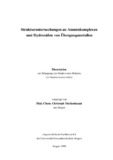Zitierlink:
https://nbn-resolving.org/urn:nbn:de:hbz:467-1547Dateien zu dieser Ressource:
| Datei | Beschreibung | Größe | Format | |
|---|---|---|---|---|
| mockenhaupt.pdf | 2.6 MB | Adobe PDF |  Öffnen/Anzeigen |
| Dokumentart: | Doctoral Thesis | Titel: | Strukturuntersuchungen an Amminkomplexen und Hydroxiden von Übergangsmetallen | AutorInn(en): | Mockenhaupt, Christoph | Institut: | Fachbereich 8, Chemie - Biologie | Schlagwörter: | ammoniates, brucit type hydroxides, hydrogen bonds | DDC-Sachgruppe: | 540 Chemie | GHBS-Notation: | UZS | Erscheinungsjahr: | 1999 | Publikationsjahr: | 2006 | Zusammenfassung: | Die Kristallstrukturen und IR-Spektren einige Ammoniakate, Co(OD) 2 und Mn 2 (OH) 3 Cl wurden im Hinblick auf ihr Wasserstoffbrückenbindungsverhalten untersucht. [Ni(NH 3 ) 6 ]SO 4 , [Cu(NH 3 ) 5 ]SO 4 und β-Mn 2 (OH) 3 Cl kristallisieren in der monoklinen Raumgruppe P2 1 /c mit a = 705,0(1), b = 1195,2(2), c = 1180,0(2) pm, β = 96,14(3)°, Z = 4, beziehungsweise in der orthorhombischen Raumgruppe Pnma mit a = 707,1(1), b = 1065,5(2), c = 1199,0(2) pm, Z = 4, und a = 650,02(2), b = 712,39(3), c = 953,10(3) pm, Z = 4. IR-Spektren von mikrokristallinen Zn(NH 3 ) 2 Br 2 und Ni(NH 3 ) 2 X 2 (X = Cl, Br) und ihre isotopen verdünnten Proben zeigen, daß die Wasserstoffbrückenbindungen in diesen Verbindungen stärker als in den entsprechenden oktaedrischen Komplexen sind. Die großen Unterschiede in den N⋅⋅⋅O-Abständen und den OD-Streckschwingungsfrequenzen für [Ni(NH 3 ) 6 ]SO 4 und [Cu(NH 3 ) 5 ]SO 4 weisen auf unterschiedlich starke Wasserstoffbrückenbindungen hin. Der vorhergesagte Brucit-Typ für Co(OD) 2 wurde bestätigt (P-3m1, a = 317,79(4), c = 464,2(1) pm und Z = 1). In der IR-Spektren der isotopen verdünnten Spektren wurden zwei anstatt nur einer erwarteten Bande beobachtet. Aufgrund der geringen Loslichkeit Brucit-Typ Hydroxiden führt der sehr langsame H/D-Austausch zu einer Mischung von voll und partiell deuterierten Spezies. In β-Mn 2 (OH) 3 Cl bilden die Wasserstoffatome mit ihren Positionen zwischen O und Cl Wasserstoffbrückenbindungen aus. Das Histogramm der O-H-Abstände in Brucit-Typ-Hydroxiden zeigt einen durchschnittlichen Abstand von 94 - 96 pm. Im Gegensatz zu den c Gitterkonstanten korrelieren die a Gitterkonstanten gut mit den mittleren M-O-Abständen. Die mittleren Metall-Sauerstoffabstände der ersten Koordinationssphäre korrelieren nicht mit Frequenzen der OH-Streckschwingungen. Zusammen mit der Rotverschiebung der OH-Valenzschwingungen bei zunehmendem Druck und den kurzen OH-Abständen weist alles auf schwache, dreifach gegabelte Wasserstoffbrücken in diesen Verbindungen hin. The crystal structures and IR-spectra of some ammoniakates, Co(OD) 2 , and Mn 2 (OH) 3 Cl have been determined with a view to study hydrogen bonding in these compounds. [Ni(NH 3 ) 6 ]SO 4 , [Cu(NH 3 ) 5 ]SO 4 and Mn 2 (OH) 3 Cl crystallize in the monoclinic space group P2 1 /c with a = 705.0(1), b = 1195.2(2), c = 1180.0(2) pm, β = 96.14(3)°, Z = 4, in the orthorhombic space group Pnma with a = 707.1(1), b = 1065.5(2), c = 1199.0(2) pm, Z = 4, and a = 650.02(2), b = 712.39(3), c = 953.10(3) pm, Z = 4, respectively. IR-spectra of microcrystalline Zn(NH 3 ) 2 Br 2 and Ni(NH 3 ) 2 X 2 (X = Cl, Br) and their isotopically diluted derivatives indicate that hydrogen bonds in these compounds are stronger than in the respective octahedral complexes. The broad range of N⋅⋅⋅O distances and OD stretching vibrations in [Ni(NH 3 ) 6 ]SO 4 and [Cu(NH 3 ) 5 ]SO 4 gives evidence for hydrogen bonds of very different strength. The predicted brucite type of Co(OD) 2 was confirmed (P-3m1, a = 317.79(4), c = 464.2(1) pm and Z = 1. In spectra of isotopically diluted samples two OD-stretching vibrations instead of the one expected were observed. The reason is found in the slow H/D exchange in these brucites with very low solubility, which leads to mixtures of fully and partially deuterated species. In Mn 2 (OH) 3 Cl both hydrogen atoms in positions directly between O and Cl take part in hydrogen bonding. A histogram of the O-H distances in brucite type hydroxides shows that the average distances are in the range 94-96 pm. Contrary to the lattice constants c the lattice constants a correlate well with the average O-H distances. The mean metal-oxygen distances of the first coordination sphere do not correlate withe the frequencies of the OH-stretching modes. Together with the red-shift of the OH valency modes with increasing pressures and the short O-H distances this is an indication for weak trifurcated hydrogen bridges in these compounds. |
URN: | urn:nbn:de:hbz:467-1547 | URI: | https://dspace.ub.uni-siegen.de/handle/ubsi/154 | Lizenz: | https://dspace.ub.uni-siegen.de/static/license.txt |
| Enthalten in den Sammlungen: | Hochschulschriften |
Diese Ressource ist urheberrechtlich geschützt. |
Seitenansichten
354
checked on 25.11.2024
Download(s)
198
checked on 25.11.2024
Google ScholarTM
Prüfe
Alle Ressourcen in diesem Repository sind urheberrechtlich geschützt, soweit nicht anderweitig angezeigt.

